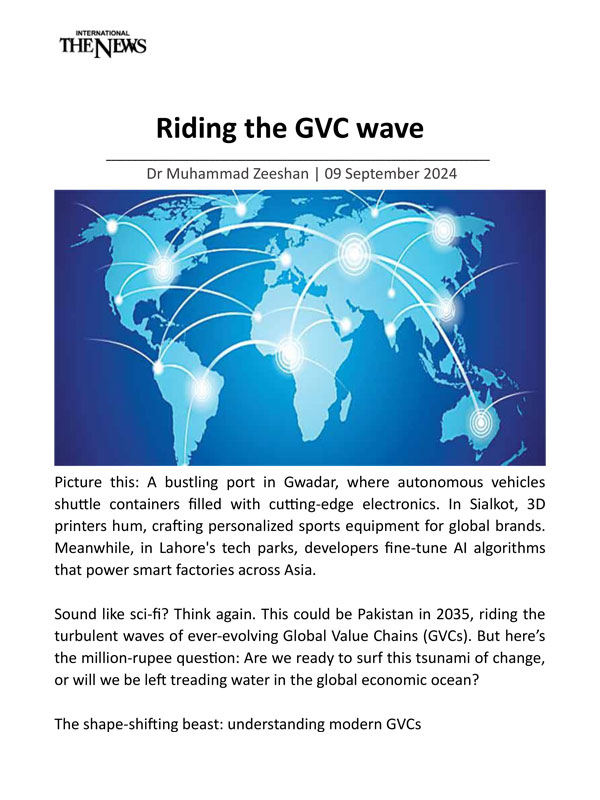
Pakistan Institute of Development Economics
- Home
Our Portals
MenuMenuMenuMenuMenuMenuMenu - ResearchMenuMenuMenuMenuMenuMenuMenu
- Discourse
- The PDR
- Our Researchers
- Academics
- Degree Verification
- Thesis Portal
- Our Portals
Riding the GVC wave
Picture this: A bustling port in Gwadar, where autonomous vehicles shuttle containers filled with cutting-edge electronics. In Sialkot, 3D printers hum, crafting personalized sports equipment for global brands. Meanwhile, in Lahore’s tech parks, developers fine-tune AI algorithms that power smart factories across Asia.
Sound like sci-fi? Think again. This could be Pakistan in 2035, riding the turbulent waves of ever-evolving Global Value Chains (GVCs). But here’s the million-rupee question: Are we ready to surf this tsunami of change, or will we be left treading water in the global economic ocean?
The shape-shifting beast: understanding modern GVCs
Let’s get one thing straight – the GVCs of tomorrow won’t look like the GVCs of today. These aren’t your grandfather’s static supply chains. We’re talking about a living, breathing, constantly mutating economic ecosystem.
Remember when ‘Made in China’ was on everything? Those days are gone. Today’s products might be designed in California, use AI developed in India, components from Vietnam, and be assembled in Mexico. Tomorrow? Who knows! And that’s the point.
For Pakistan, this flux is both thrilling and terrifying. We can’t just find our place in existing chains – we need to anticipate where they’re headed and position ourselves accordingly. It’s like trying to hit a moving target while riding a roller coaster. Exciting? Yes. Easy? Not a chance.
From cotton fields to code farms: Pakistan’s GVC evolution
Let’s talk transformation. For decades, Pakistan’s GVC story was all about textiles. We were the cotton kings, the denim dreamers. But in the age of fast fashion and smart fabrics, that’s old hat.
Don’t get me wrong – textiles aren’t dead. But they’re evolving. Imagine Pakistani factories churning out smart clothes that monitor your health or fabrics that change color with your mood. That’s where we need to be.
But here’s the kicker – we can’t stop there. The real opportunity? It’s in jumping into entirely new value chains. Take electric vehicles (EVs). With the right moves, we could be producing batteries, manufacturing components, or even developing software for the EVs of tomorrow. It’s a leap, sure, but who says Pakistan can’t be the next EV hub?
The AI Revolution: GVCs in the age of algorithms
Hold onto your hats, because AI is about to turn GVCs upside down. We’re not just talking about robots in factories (though that’s part of it). We’re talking about AI optimizing entire supply chains, predicting market trends, and revolutionizing product design.
For Pakistan, this is a golden ticket. We’ve got a young, tech-savvy population hungry for opportunities. Why can’t we be the AI brains behind tomorrow’s GVCs? Picture Pakistani data scientists optimizing global shipping routes or our AI experts fine-tuning predictive maintenance for factories across Asia.
But – and it’s a big but – we need to move fast. The AI train is leaving the station, and we need to be on it, not waving from the platform.
Green is the new black: sustainability in GVCs
Here’s another curveball – sustainability is reshaping GVCs faster than you can say ‘carbon footprint’. Companies are scrambling to green their supply chains, and this creates a massive opportunity for Pakistan.
Think about it. We’ve got abundant sunlight and wind. Why not position ourselves as the go-to hub for green manufacturing? Solar-powered factories producing eco-friendly goods – that’s a value proposition that will have global brands drooling.
But it’s not just about slapping solar panels on roofs. It’s about fundamentally rethinking how we participate in GVCs. Can we develop expertise in recycling technologies? Can we pioneer new, sustainable materials? The possibilities are endless, and the time to act is now.
The million-dollar question: are we ready?
So here’s the bottom line, folks. Global Value Chains are evolving at breakneck speed, creating opportunities we can barely imagine. For Pakistan, it’s the economic equivalent of a gold rush. But like any gold rush, the real winners won’t be the ones who just show up – they’ll be the ones who bring the right tools and know how to use them.
We’ve got the raw ingredients – a young population, a strategic location, and untapped potential in spades. But do we have the vision? The agility? The sheer audacity to reimagine our place in the global economy?
The GVCs of tomorrow are up for grabs. The question isn’t whether Pakistan can participate – it’s whether we’re ready to lead the dance. Are we ready to transform from followers into innovators, from observers into shapers of the global economic order?
The writer is head of research group, Trade, Industry & Productivity (TIP) at the Pakistan Institute of Development Economics (PIDE), Islamabad.



